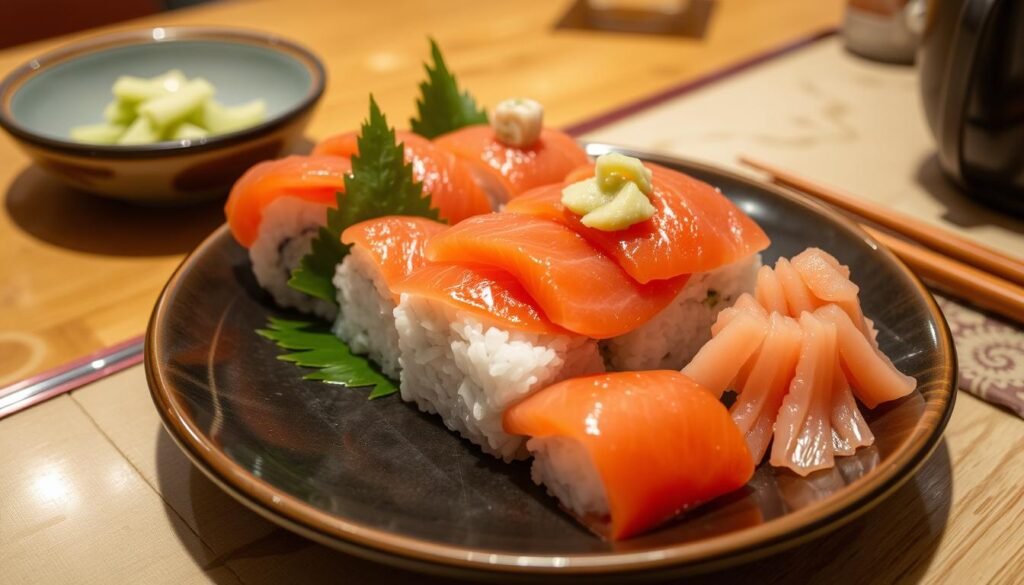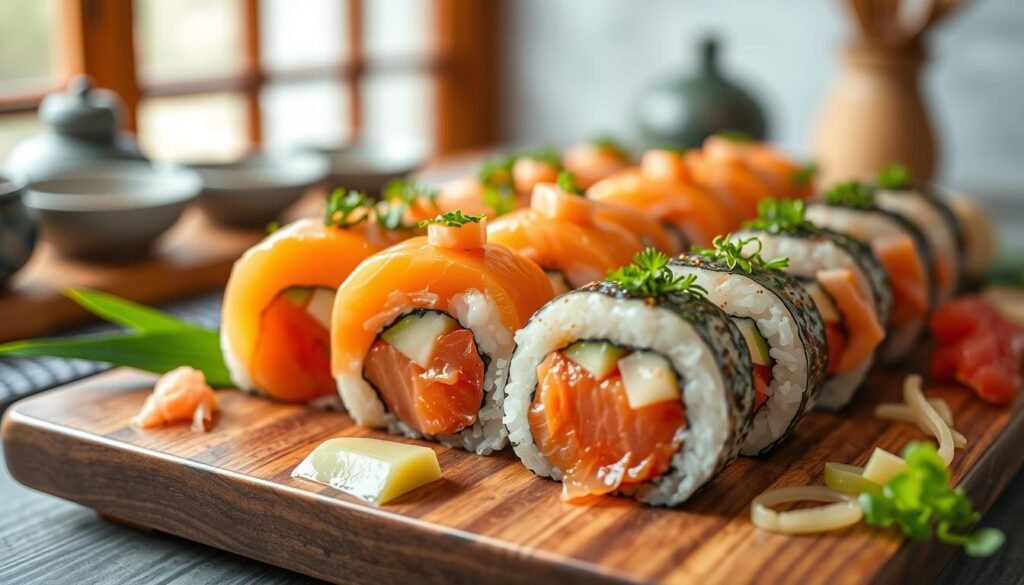The smell of fresh salmon sushi fills the air, making me feel joyful. Salmon sushi has been a big part of my food adventures. It shows me the rich tastes and lively textures of Japanese food.
Whether I eat it at a sushi place or make it myself, it’s always amazing. This dish takes me to a world of great food.
Salmon sushi is a mix of fresh fish and seasoned rice, showing off sushi-making skills. Every bite is a burst of flavor that excites the senses. I’ve learned a lot about its history and cultural importance.
Understanding Traditional Salmon Sushi Origins
Salmon was not a common ingredient in sushi until the 1980s. Before then, the Japanese didn’t often use salmon in their sushi. This was because of worries about parasites in Pacific salmon, making them unsafe to eat raw.
Evolution of Salmon in Japanese Cuisine
In the 1980s, Norwegian farmed salmon changed everything. The first Norwegian salmon was brought to Japan in 1980, but it was for grilling, not sushi. A big marketing push, called “Project Japan,” aimed to make Japanese people like Norwegian salmon.
This campaign worked well. Salmon exports to Japan went from 400 million NOK to 1.8 billion NOK by the late 1980s. By the mid-1980s, salmon started being used as a sushi topping and quickly became popular.
Cultural Significance in Modern Sushi
Now, salmon sushi is a big deal in Japan and loved worldwide. Salmon’s success in Japan showed a big change. You can see plastic sushi models in Tokyo restaurant windows, showing how much salmon is loved.
“Salmon sushi gradually became popular in Japan, especially in conveyor belt sushi restaurants. Salmon sushi is described as having a buttery, creamy, melt-in-your-mouth texture that became appealing to Japanese consumers.”
The story of salmon in sushi shows how food traditions can change. The introduction of Norwegian salmon and ongoing marketing efforts changed how the Japanese see and enjoy this fish. Now, salmon is a key part of Japanese sushi and sashimi.

Essential Ingredients for Perfect Salmon Sushi
To make delicious salmon sushi at home, you need a few key ingredients. The base of any sushi is sushi rice. It’s a special short-grain white rice seasoned with rice vinegar, sugar, and salt. This rice is sticky and flavorful, making it perfect for the fresh salmon.
Other important parts include nori (seaweed sheets), wasabi, and soy sauce. Nori wraps the sushi rolls. Wasabi and soy sauce add a pungent kick and savory depth.
- Sushi-grade salmon: It’s vital to use the freshest, sashimi-quality salmon for delicious, safe sushi. Don’t use regular supermarket salmon.
- Short-grain sushi rice: This rice is essential for holding sushi rolls together and giving them the traditional texture.
- Rice vinegar, sugar, and salt: These seasonings turn plain rice into the flavorful sushi rice that’s the heart of the dish.
- Nori seaweed sheets: Wrapping the sushi in these crisp, savory sheets of dried seaweed is a must.
- Wasabi and soy sauce: These signature condiments add heat and umami notes to balance the flavors of the sushi.
With these essential ingredients, you’ll be on your way to making restaurant-quality salmon sushi at home. The secret is to use the highest-quality components and follow precise preparation techniques. This will help you achieve that perfect sushi experience.
Types of Salmon Used in Sushi Making
Sushi fans love the taste of salmon sashimi and sushi. Salmon in Japanese food comes in many flavors, from rich and buttery to light and delicate. As sushi becomes more popular worldwide, knowing the different salmon types is key.
Sushi-Grade vs Regular Salmon
Sushi-grade salmon is safe to eat raw. It’s frozen to kill parasites, perfect for sashimi and sushi. Regular salmon, however, is cooked before eating because it’s not safe raw.
Wild-Caught vs Farm-Raised Options
Wild-caught salmon tastes richer and is firmer, making it the top choice for sushi. But, farm-raised salmon is more common and can be good if prepared right. It’s important to source and handle both types responsibly.
Proper Storage and Handling
- Keep sushi-grade salmon frozen to keep it fresh and safe.
- Be careful when handling the salmon to avoid contamination.
- Choose salmon from trusted suppliers who follow food safety rules.
“Salmon sushi is a beloved staple in Japanese cuisine, offering a delicate balance of flavors and textures that have captivated sushi enthusiasts around the world.”
Mastering Sushi Rice Preparation
Making perfect sushi rice is key to great salmon sushi. It needs careful steps, like rinsing the rice and seasoning it right. You’ll use rice vinegar, sugar, and salt for the flavor.
Start by rinsing the sushi rice 3 times to get rid of starch. Use a 1:1 ratio of rice to water for fluffy, sticky grains. After cooking, let the rice rest in a bowl for 20 minutes to blend the flavors.
Then, mix the sushi vinegar seasoning. Combine 1/2 cup of rice vinegar, 1/4 cup of sugar, 2 teaspoons of salt, and 2 tablespoons of mirin. Fold this mixture into the rice gently to keep it fluffy.
Once the rice has rested for 20 more minutes, it’s ready for your salmon sushi. Keep it covered with a damp towel to keep it fresh and right before shaping.
Learning to make sushi rice is the first step to making delicious salmon sushi. With the right steps and care, you’ll make sushi that’s as good as any Japanese chef’s.
Salmon Sushi Variations and Styles
The world of salmon sushi is full of flavors and textures. You can enjoy it in many ways, from classic nigiri to maki rolls. Nigiri is simple, with fresh salmon on top of rice. Maki rolls wrap the salmon in seaweed, mixing flavors and textures.
Nigiri vs Maki Rolls
Nigiri and maki rolls are both loved for salmon sushi. But they’re different. Nigiri lets the salmon shine, while maki rolls add more ingredients like avocado and cucumber.
Contemporary Fusion Varieties
Salmon sushi is always changing. New styles mix Japanese flavors with international ones. The salmon sushi bake is a great example, with creamy and crunchy toppings.
“Salmon sushi has become a global phenomenon, with each style and variation offering a unique taste experience.”
Salmon sushi is an adventure, whether you like nigiri or maki rolls. It’s a mix of tradition and new ideas, loved by sushi fans everywhere.
The Art of Salmon Sushi Assembly
Making salmon sushi is an art that needs precision and detail. Whether you’re making nigiri or maki rolls, it’s a series of steps. Each step is important for the final dish.
To make perfect salmon nigiri, start by shaping sushi rice into an oval. Place a thin slice of fresh salmon on top. The slice should be 7cm wide, 3cm tall, and 0.5cm thick. This size ensures the right balance of rice and fish.
- For maki rolls, spread sushi rice on nori (dried seaweed). Place salmon and other fillings in the middle. Roll it tightly using a bamboo mat.
- When cutting maki rolls, sharp knife skills are key. A kiritsuke knife is best for clean cuts.
Presentation is key in sushi making. Arrange salmon nigiri and maki rolls carefully. Add avocado, cucumber, or wasabi for extra flavor and beauty.
“The beauty of sushi lies in its simplicity. Each ingredient must be handled with the utmost care to preserve its natural flavors and textures.”
By following these steps, you can become a pro at making salmon sushi. You’ll create a dish that looks great and tastes amazing.
Essential Sauces and Condiments
Enhancing the taste of salmon sushi needs the right sauces and condiments. These include both classic Japanese flavors and new twists. They turn a simple sushi meal into a feast for the senses.
Traditional Accompaniments
The core of sushi dining is soy sauce, wasabi, and pickled ginger. Soy sauce, like shoyu and tamari, adds a deep, savory taste. Wasabi’s heat balances the richness of the salmon. Meanwhile, pickled ginger’s sweetness and tanginess refreshes your palate.
Modern Sauce Innovations
- Spicy mayo, made with mayonnaise, sriracha, and sesame oil, brings a creamy, spicy kick.
- Eel sauce, a sweet and savory teriyaki-like sauce, glazes grilled or broiled salmon sushi beautifully.
- Ponzu, a zesty soy vinaigrette, adds a tangy, refreshing touch to the salmon’s natural taste.
These modern sauces let sushi lovers try new flavors and make their meal their own. They take salmon sushi to new heights of taste.
“The key to exceptional salmon sushi lies in the harmonious balance of flavors, where the delicate fish is enhanced by the perfect pairing of traditional and innovative sauces and condiments.”
Nutritional Benefits of Salmon Sushi
Salmon sushi is packed with good stuff for your body. It’s full of omega-3 fatty acids that help your heart and brain. Salmon also has lots of protein, which is great for muscles.
It’s also a good source of vitamins like D, selenium, and B vitamins. These vitamins help keep you healthy overall.
When you eat salmon sushi, you get a mix of protein, healthy fats, and carbs. But, watch out for sodium from soy sauce and sugars in some sushi. Eating it in balance can boost your heart, brain, and immune system.
The way salmon is prepared in sushi has its own perks. Eating raw salmon might lower cancer risk and improve heart health. But, make sure to eat it safely to avoid getting sick.
Ingredients
For the Sushi Rice:
1 cup (200 grams) uncooked Japanese short-grain rice
1 1/4 cups (300 ml) water (for cooking the rice)
1/4 cup (60 ml) rice vinegar
1 tablespoon (12 grams) sugar
1 teaspoon (6 grams) salt
For the sushi fillings and Wrap:
1/2 pound (225 grams) sushi-grade salmon, thinly sliced
4 sheets nori (seaweed)
Wasabi, as needed (optional)
For Serving:
Soy sauce, as needed
Pickled ginger (optional, for garnish)
Execution
Cook the Sushi Rice
Rinse 1 cup of Japanese short-grain rice until water runs clear. Cook with 1 1/4 cups of water in a rice cooker or on the stovetop. Let it steam for 10 minutes after cooking.
Season the Sushi Rice
Mix 1/4 cup rice vinegar, 1 tablespoon sugar, and 1 teaspoon salt. Gently fold the mixture into the warm rice, then let it cool to room temperature under a damp towel.
Prepare the Salmon
Slice 1/2 pound of sushi-grade salmon into thin pieces, about 2 inches wide and 1/4 inch thick. Refrigerate until ready to use.
Set Up Your Sushi Station
Place a bamboo sushi mat covered with plastic wrap on a flat surface. Lay a sheet of nori shiny side down, and keep a bowl of water nearby.
Assemble the Sushi
For nigiri, shape 1 tablespoon of rice into an oval and lay a slice of salmon on top. For maki rolls, spread rice on nori, add salmon and optional fillings, then roll tightly.
Slice and Serve
Use a sharp knife dipped in water to slice rolls into 6–8 pieces. Arrange on a plate and serve with soy sauce, wasabi, and pickled ginger. Enjoy!
Additional tips
- Use sushi-grade salmon: Always choose the freshest, sashimi-quality salmon for safe and delicious sushi.
- Keep ingredients chilled: Refrigerate salmon, rice, and fillings until you’re ready to assemble the sushi to maintain freshness.
- Wet your hands and knife: Prevent sticking by dampening your hands when handling rice and your knife when slicing rolls.
- Add creative fillings: experiment with avocado, cucumber, or cream cheese to customize your rolls.
- Practice rolling techniques: Use a bamboo mat to roll tightly and evenly for professional-looking sushi.
- Serve immediately: Enjoy your sushi fresh for the best flavor and texture.
- Experiment with sauces: Try spicy mayo, eel sauce, or ponzu for unique flavor combinations.
FAQ
What is salmon sushi?
How did salmon become a popular sushi ingredient?
What are the key ingredients for making salmon sushi?
What is the difference between sushi-grade salmon and regular salmon?
How do you prepare the sushi rice for salmon sushi?
What are the different styles of salmon sushi?
How do you assemble salmon sushi?
What are the traditional accompaniments for salmon sushi?
What are the nutritional benefits of salmon sushi?
Conclusion
Salmon sushi stands out not only for its exquisite flavor and appealing presentation but also for its nutritional benefits and cultural significance. As a beloved staple in Japanese cuisine, it invites enthusiasts and newcomers alike to explore the diverse world of sushi. By embracing this culinary art, one can appreciate the craftsmanship behind each roll and the freshness of the ingredients. To further enhance your understanding and appreciation of salmon sushi, check out related resources that delve into recipes, preparation techniques, and the fascinating history of this dish.




